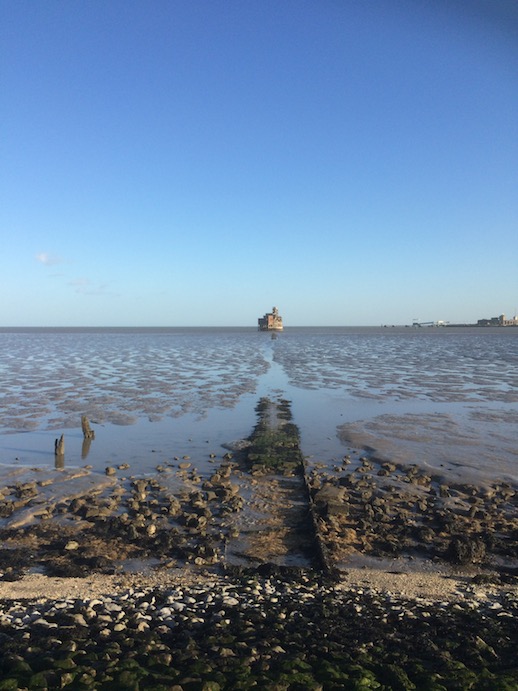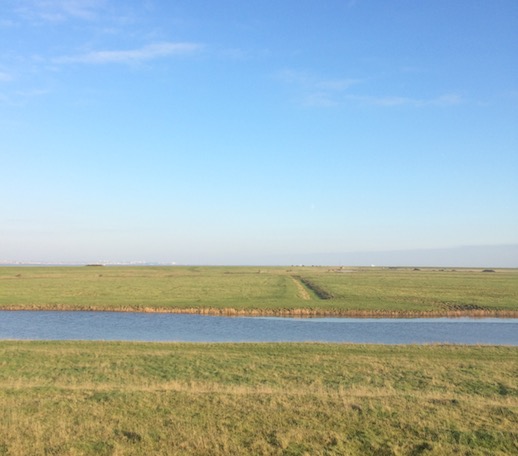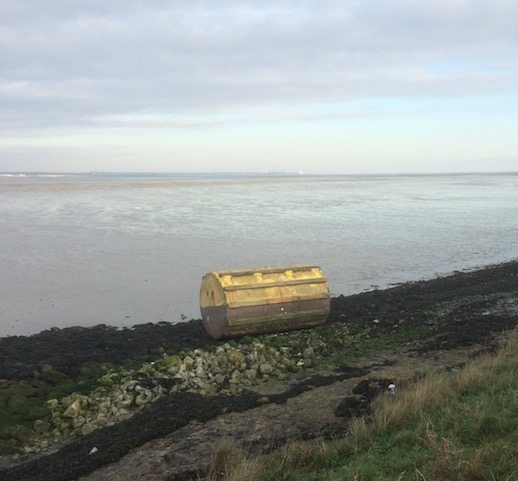Words and pictures: Luke Turner
Grain Tower, built in 1855, stands a kilometre out from the coast of The Isle of Grain on the edge of Kent and at the end of England. Originally just a circular Martello-style granite elephant leg stomped firmly in the Thames’ estuarine ooze, it was added to in the First and Second World Wars. Reinforced concrete struts interrupt the smooth lines of the original Victorian stonework to support crude, hastily-built brick structures thrown up as menace loomed across the waters of the North Sea. It rises to a viewing platform with an open slit that peers towards the horizon like the open visor of a medieval knight.
Grain Tower is for sale, given the salubrious address of Number 1, The Thames, and according to property website Rightmove (which rather optimistically describes the decaying mass of steel, brick and stone as a five bedroom house) it can be yours for a cool £500,000. The estate agents have been admirably creative, including architects drawings and the promise that though “The property is of course in need of complete renovation [it] could be transformed into almost anything…a private residence, an off shore hotel, outdoor pursuit centre, film location, nightclub, casino to name a few!” I first came across this strange structure when I was helping out the group One More Grain release their second album, named after the Isle of Grain. We handed out CDs with sleeves made from a photocopied OS map of the local area, with Grain Tower, the causeway linking it to land at low tide, the nearby power station (second highest chimney in the country), port and defunct oil refinery all present. Daniel Patrick Quinn, the leader of the group, wanted to kidnap music journalists and hold them to ransom on the tower, only releasing them in exchange for coverage in the national press. “A five out of five else you’re getting a finger in the post, Mr Mojo”. I wish we had – aside from a favourable notice from Stewart Lee, the album failed to turn the tide in favour of OMG, and shortly afterwards Quinn renounced music and travelled to the far east to climb volcanos.
This, and the general chaos that will always surround a group trying to release a strange yet brilliant record supported by no budget into the teeth of an indifferent world means that I can’t recall ever finding out why Quinn had wanted to name his record after the Isle of Grain. I suspect it’s because he went birdwatching there, it wasn’t an overly pretty place, and he got hammered on Caffreys while listening to Fela Kuti. Whatever, he set something off, and over the years I’d find myself online, looking at satellite photographs of the green fields, creeks that writhed like the casts of worms, and the faded browns of former industrial sites, wondering.
As last year faded into this I was invited on a New Year’s escapade to a lonely barn on the Cliffe Marshes (adjacent to Grain) by kind friends concerned I shouldn’t be left alone at the end of a grim year that had seen the final ebb of a five year relationship. We drove along the A2 out of London, a short delay passing a queue of cars greedy for the sales at Bluewater shopping centre, then off to the village of Cooling, where ten tiny coffin-shaped tombstones in St James churchyard gave Charles Dickens the inspiration for the orphan Pip in Great Expectations. It is here where, in that novels’ opening scene, he first meets the convict Magwitch in the moment that will send his life away from the bleak marsh, for a time at least. On this bright winter’s day, sun streamed through the stained glass windows of the church, casting pink light onto a dead fly lying next to the monument to a drowned sailor. The church used to be on the edge of the marsh, but now you look over the gardens of executive homes and across farmland to the river. In the distance on the northern bank in Essex the gigantic cranes of the new London Gateway superport stand arms raised, skeletal trumpeters welcoming the vessels they’re to unload. They play flat, though, and giant booms and clangs echo from the port across the estuary, bass note to the call of tens of thousands of seabirds and waders.
In four days we barely saw a soul on the marshes, no walkers or farmers between the barn-meets-scrapyard where we were staying and sails and superstructures gliding back and forth behind the sharp line of the sea wall a mile or so away. Drainage ditches shimmered with the blue of the sky or, when frozen and hit by stones, hummed like rails under an approaching train. An abandoned concrete hut was decorated inside with the tags of amateur local gangs. On the outside, in giant letters covering the whole wall, was painted the bizarre slogan ‘Eat Heron Meat’.
The confined space of the barn, 11 people packed in with enough ale to drown a creche, felt intense compared to the space outside. I’d wander off from the group on walks, trying to quieten the ghosts of what had happened last November. At the end of love the mind creates dangerous and murky channels of what might have been, raises idealised memories of solid ground that actually never was. In the distance that sea wall, holding back the power of the Thames, looked sharp and clear. Up close however it was scattered with detritus and jetsam – plastic bottles, a football, part of a yacht’s decking, a dead bird, a huge yellow mooring buoy adrift and come ashore. One More Grain’s music, and Quinn’s own solo work, have always struck me as being accounts of a man walking off his mind’s own beaten path, monologues narrated over trumpet that calls like a strong wind hollowed out by trees or pylons, rhythms just fractured enough to lead the ears astray. His words kept coming back to me as I walked, fragments that struck nerves: “have a heart / have a heart”… “the graffiti in the toilet says I’m going to be fine” … “I lost the number to the breakdown service / but I was having a ball”… “sometimes all you can do is leave it to the waves / and roll a dice for next year”.
New Year’s Day was stormy, the wind so strong it made cupboard doors within the barn rattle, but January 2nd dawned bright. I drove out to the end of the Isle of Grain along a road lined with officious yet desperate signs, pleas for motorists to slow down. Three groups of flowers marked the demise of those who hadn’t. A mattress burned on a pile of waste outside a cottage, chimneys and gas storage tanks glowed in the light above creeks and fields, a landscape at once rural, wild, and industrial. The tide was going out past the base of Grain Tower, connecting it once more to the land, waves rustling against the mud far away towards the rusting masts of the wreck of the SS Richard Montgomery, the sunken Liberty Ship packed with 1,400 tonnes of decaying explosives that could (in theory) go off at any moment, returning all this to oomska. The Isle of Grain is a blank canvas, and anything might be built on this supposed waste where malaria once thrived – Boris Johnson dreamed of destroying it all and replacing it with his giant airport. The wreck of the SS Richard Montgomery was partly what had scuppered his plans. I climbed onto an old fortification, a circle of bolts that once held a gun casting shadows like a miniature military industrial Henge, and looked out across the sea. You couldn’t build an airport here, for nothing so monolithic and vast feels right in a landscape as transient as the birds who stop here on their migrations. That gigantic power station is to be decommissioned, and will be gone soon. In my head I heard Walking Off The Map, the last track on Isle of Grain, and Daniel Quinn’s words wandered over the edges of my mind: “This place was here before / On occasions… It’s good to be lost.” We’ll all move on.
——————————————————————————————————————————-
Luke Turner is co-founder and editor of online music and arts magazine The Quietus. He has also contributed to Q, The Guardian, NME, MOJO and the BBC and is currently researching a book on London’s Epping Forest.


